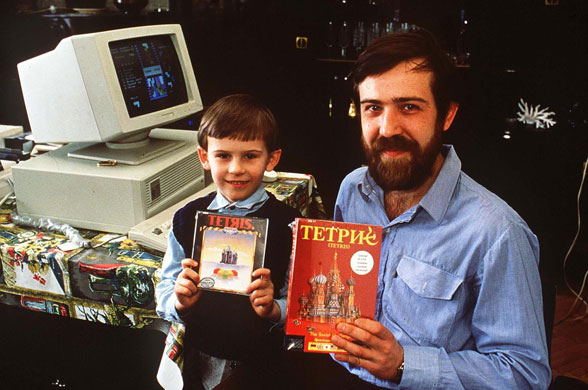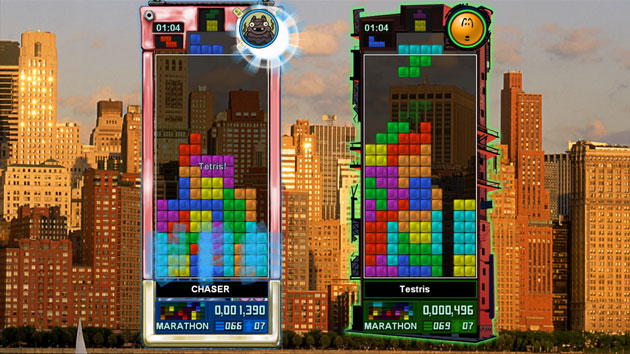
 6.6.09
6.6.09It’s odd to think, with today’s gaming culture, high-definition graphics and internet-based, 256 player battles, that even twenty-five years ago, gaming was going strong. True, it might not have been the most immersive or graphically intense gameplay ever to have graced a gaming platform, but it was gaming nonetheless, and today – twenty five years since what I consider as the beginning of the gaming culture we know and enjoy now – we pay our tribute to the legend which catapulted gaming from tech-heads in a dark room to pensioners in bungalows, children in playgrounds, and pregnant mothers approaching labour in a hospital bed. That game is, of course, Tetris.
Over twenty five years, much has changed. Berlin is now one city, instead of two divided up by a very large garden wall; British Telecom has been privatised; and we’ve had at least three different prime ministers. But one thing that hasn’t changed: the success and popularity which one small, not-so-technically-advanced game developed on a Soviet Elektronika 60 computer came to have.

While studying at the Soviet Union’s Academy of Science, a twenty-nine year old Alexey Pajitnov first designed the bare bones for a game which would, eventually, go on to define the term ‘arcade gaming’. Inspired by the classic riddles and puzzles which Pajitnov was so fond of as a child, the earliest version of what we now know as Tetris was only ten levels long – a restriction of the hardware which the game was first designed on. The game became known as ‘Tetris’ – a title created from a combination of the Greek prefix ‘tetra’, meaning ‘four’, and the name of Pajitnov’s favourite sport: tennis.
"The program wasn't complicated," Pajitnov told the Guardian. "There was no scoring, no levels. But I started playing and I couldn't stop. That was it."

The concept wasn’t at all complicated: from the top of the screen a series of differently-shaped "blocks" fall slowly towards the bottom. The player can turn each block as it falls or move it sideways, but at the lowest point the block will stay and a new one will begin falling. If the blocks fill a line without gaps, they disappear, and the player gains points. Otherwise they pile up, giving the player less and less time before they hit the "bottom". Allow the blocks to pile up to the top of the screen, and it’s game over.
And that was the beauty of Tetris – it’s utter simplicity. It made it fun and frustrating, amazing and addictive all at once. It infested the dreams of those who played it, and was even (at one point) considered by the US as a possible Soviet plot to distract the youth of the US. There’s no denying that, in some form, Tetris has been spoken about by pretty much every person on the planet.

The game’s success didn’t really start until 1988, when a Dutch games publisher by the name of Henk Rogers saw potential in Pajitnov’s brain child.
"I first saw it at the Consumer Electronics Show in Las Vegas in January of 1988. My first impression was that this game was too simple, that there was nothing to it. Then I came back and played it again. And again. Soon I realised there was something going on – no game had grabbed me at a show just like that."
And it was that moment which made Tetris into what we know now – two people, one product, the right place at the right time. Rogers fought off heavy competition in order to secure the rights to Pajitnov’s Tetris, and – with the help of ally and then-boss of Nintendo America, Minoru Arakawa – managed to propel Tetris to success, bundled with every Game Boy.
It was this love affair with Nintendo’s handheld, the Game Boy, that made Tetris a household name. Without the backing of such as popular games system behind it, Tetris may well have faded away into the oblivion of time, lost somewhere back in the 1980’s, its genius undiscovered. But Henk Rogers was a motivated, determined, driven Dutchman, and with his expertise and connections he managed to license the game’s rights to companies worldwide.
However, the success of Tetris barely made an impression on Pajitnov – partly because he didn’t start earning anything from Tetris until 1996, when the rights for the game finally reverted back to him when he left to pursue a career with Microsoft in the US. Before then, all the royalties were claimed by the Kremlin, as – under Russia’s then-communist leadership – the rights for the game belonged to the state.
Both Pajitnov and Rogers now work on licensing the game to developers and publishers worldwide. And the popularity of Tetris shows no likelihood of slowing – one game developed deep in the bowels of the Soviet Academy has spawned hundreds of different versions on various platforms, art, television shows, scientific experiments and even furniture.
And we mustn’t forget that, without the kick-start that was Tetris, gaming may never have made the geek to chic change which now makes gaming a multi-million pound, worldwide followed industry. Which is why I am proud to pay tribute to the grandfather of modern gaming: Tetris.
Linford
Labels: Tetris, Tribute, Writer's note
Discuss this article in our friendly forums
Sign up to our community today and discuss our articles, debate over upcoming games and organise matches and playsessions with like-minded people just like you.Done? You might also enjoy these!
Comments
All comments are subject to our commenting policy
Subscribe to our content
and never miss a single thing
Search
delve deep into our archives
Latest videogames news
read all the latest headlines
Our most recent reviews
Latest videos
Subscribe on YouTube
Our twittering
Miscellanous miscellany

- We've saved some space for future Friends of GGTL. If you'd like to work with us on projects, please do get in touch.
A Gamer's Guide to Life Network website
Originally founded by Matthew Meadows in 2007






